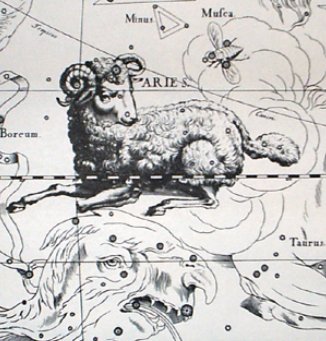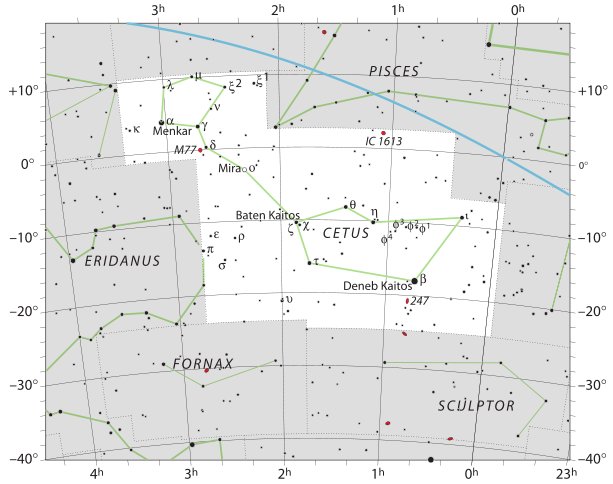A pattern with 5 glyphs from Cb1-9 ends with glyph 8 + 5 = 13:
I have blackmarked the star names Delta (Δ) and Deneb Kaitos (the 'tail' of the Sea Beast, β Ceti), because this was earlier than the light flames from Achird.
The RA fraction of Deneb Kaitos (0.4) makes it fit with the Arab structure.
Also η Phoenicis had the fraction 0.4, but I guess Deneb Kaitos was more important. For Baten Kaitos (the 'belly' of the 'Fish', ζ Ceti) rose with the Sun at the same time (26.6) as Polaris - in the day before the Sun was 'making landfall' at the First Point of Aries:
...Then the big Fish did swallow him, and
he had done acts worthy of blame.
But We cast him forth on the naked shore
in a state of sickness,  From Deneb Kaitos to the First Point of Aries there were 27.4 - 9.4 = 18 nights ('out at sea'). We should now jump to the beginning of the back side of the tablet in order to look at its first glyphs. The position of heliacal Deneb Kaitos (10) - 63 days from 'January 1 - on side a can be compared with the position of the 'fist held high' on side b:
Then comes a bird of the type which normally has its beak open like a cock crying out in the early mornings, but which here has fallen silent - resembling the always quiet manu rere ('bird spirits', ghosts): ... The transportation of the stone figure from Hiva is not a historical authentic voyage because all the protagonists are spirits. Kuihi and Kuaha, the guardian spirits of the immigrant king, who are at his side at crucial moments (Oroi conflict, hour of death), transport the (deliberately severed) head of the stone figure to the beach of the royal residence. From there, a servant of the king, who is mentioned by name, carries the fragment of Oto Uta to Hotu Matua's house. If the last segment of the tradition is to be taken literally, the stone ancestor's head did not weigh more than what a man can carry. The three 'fellows' (kope), commissioned by the king to bring the figure of Oto Uta unharmed from Hiva, all have names of spirits (akuaku) that live in the sea near Vai Hū and Hanga Tee on the southern shore. My informants (Laura Hill and Vincente Pons) gave me the names of four spirits, 'Pure Henguingui', 'Pure Ki', 'Pure O' and 'Pure Vanangananga', in connection with the traditional instruction to speak softly while gathering mussles at night on the beach (of the same coastal stretch). The instruction can be explained in the following way: pure means both 'cowrie' (PPN. *pule 'cowrie') and 'prayer' - in the Easter Island script both are represented by Rongorongo 25 [my glyph type pure] - while the qualifying additions refer to various ways of speaking. RAP. henguingui is synonymous with MGV. henguingui 'to whisper, to speak low' and goes back to west Polynesian forms (SAM. fenguingui 'to talk in a low tone'; UVE. fegui 'murmurer'). In many of the Polynesian languages, ki is the spoken word; in some few, ki refers to the process of thinking; (MGV., MAO., HAW.) and in some instances, it indicates special noises (MQS. ki 'to whistle with two fingers'; SAM. 'i 'to call like a bird'; TON. ki 'to squeal'). Generally, o is the affirmative answer to the caller, while vanangananga indicates repeated speaking. The four spirits represents, on one hand, the sound scale of empty conch shells and, on the other hand, a classification of types of prayers ... It was not early morning but late in the day, when the birds had tucked their heads under their wings, the time of Pure Henguingui. The type of glyph is moa (a kind of bird which normally keeps close to the ground level instead of flying quickly all around):
I suppose side b of the tablet could refer to 'the night side', which could motivate one more 'year' in addition to the heliacal cycle on side a. The Sun would then in a way not shine on side b. An open beak illustrates light shining through - as through the gaps (vaha) between the fingers - and when this opening was closed it meant light no longer could penetrate.
In the Egyptian picture above we can count to twice 14 = 28 spaces between twice 13 = 26 'fingers'. With his left hand the man shows where the 2nd group of 7 openings is beginning.
In autumn the Sun light vanishes, which seems to be illustrated in the picture of the Mayan month Moan, a word curiously resembling moana:
Each Mayan month had 20 days and 15 * 20 = 300. Adjusting the stars one position ahead to get them in parallel with the glyphs:
When the Sun goes away, then the Serpent emerges from some hole in ground. In the picture below he is cut into 7 pieces with the aid of 6 knives (as if in contrast to 7 fingers creating 6 vaha in the mornings).
The star ξ Arietis, which on side b seems to correspond to Deneb Kaitos, rose with the Sun 5 weeks after 'February 22 (53). 53 + 35 = 88 and 88 + 183 = 271. However, after having adjusted the stars with 1 position ahead this sum changes to 272 (= 2 * 136). The idea could have been to compare the position of ξ Arietis - if looked at in the night and close to the Full Moon - with the position of May 16 (136) north of the equator. The Egyptian 'sky supporter' (djed) resembles the glyph type mea ke:
Hevelius has put ξ Arietis just below the left front leg of the Ewe (indeed even inside the top crest of Cetus).
And Bayer has put ξ¹ and ξ² Ceti (stars so far not listed by me) close by:
... The Arabian astronomers of course knew the Greek constellations and called it [Cetus] Al Ketus, from which have come Elketos, Elkaitos, and Elkaitus; but their predecessors, who had not heard of the Royal Family and its foe, separated these stars into three very different asterisms. Those in the head, α, γ, δ, λ, μ, ξ¹and ξ² , were Al Kaff al Jidmah, the Part of a Hand, from a fancied resemblance to their Stained Hand, our Cassiopeia ... ... the early Arabs had a very different figure here, in no way connected with the Lady as generally is supposed, - their Kaff al Hadib, the large Hand [cfr Caph] Stained with Henna, the bright stars marking the fingertips; although in this they included the nebulous group in the left hand of Perseus. Chrysococca gave it thus in the Low Greek Χείρ βεβαμένη; and it sometimes was the Hand of, i.e. next to, the Pleiades ... | |||||||||||||||||||||||||||||||||||||||||||||||||||||||||||||||||||||||||||||||||||||||||||||||||||||||||||||||||||||||||||||||||||||||||||||||||||||||||||||||||||||||||||||||||||||||||||||||||||||||||||||||||||||||||||||||

















